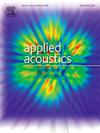TBP-XFE: A transformer-based explainable framework for EEG music genre classification with hemispheric and directed lobish analysis
IF 3.4
2区 物理与天体物理
Q1 ACOUSTICS
引用次数: 0
Abstract
Electroencephalography (EEG) signals offer important information for machine learning. In this work, we evaluate whether EEG signals can be used to classify music genres. We use a new transformer-based feature extraction method called the Three-Body Pattern (TBP). We also collected an EEG based music dataset containing five classes and these classes are: classical, popular, rap, ballad, and resting.
Our feature engineering framework operates in four phases. First, the TBP method transforms each EEG signal to extract distinct features. Second, we use cumulative weighted neighborhood component analysis (CWNCA) to select the best features. Third, a t-algorithm-based k-nearest neighbors (tkNN) classifier assigns class labels. Finally, we apply Directed Lobish (DLob) and hemispheric symbolic languages to produce clear and explainable results.
The TBP-related explainable feature engineering (XFE) framework achieved over 90% classification accuracy on the EEG music dataset. This represents a promising advancement in EEG based music classification because it produces clear and explainable outputs.
TBP-XFE:一个基于变压器的脑电音乐类型分类的可解释框架,具有半球和定向lobish分析
脑电图信号为机器学习提供了重要的信息。在这项工作中,我们评估了脑电图信号是否可以用于音乐类型分类。我们使用了一种新的基于变压器的特征提取方法,称为三体模式(TBP)。我们还收集了一个基于EEG的音乐数据集,其中包含五个类别,这些类别是:古典,流行,说唱,民谣和休息。我们的特征工程框架分为四个阶段。首先,TBP方法对每个脑电信号进行变换,提取出鲜明的特征;其次,我们使用累积加权邻域成分分析(CWNCA)来选择最佳特征。第三,基于t算法的k近邻(tkNN)分类器分配类标签。最后,我们应用定向Lobish (DLob)和半球符号语言来产生清晰和可解释的结果。与tbp相关的可解释特征工程(XFE)框架在EEG音乐数据集上实现了90%以上的分类准确率。这代表了基于脑电图的音乐分类的一个有前途的进步,因为它产生了清晰和可解释的输出。
本文章由计算机程序翻译,如有差异,请以英文原文为准。
求助全文
约1分钟内获得全文
求助全文
来源期刊

Applied Acoustics
物理-声学
CiteScore
7.40
自引率
11.80%
发文量
618
审稿时长
7.5 months
期刊介绍:
Since its launch in 1968, Applied Acoustics has been publishing high quality research papers providing state-of-the-art coverage of research findings for engineers and scientists involved in applications of acoustics in the widest sense.
Applied Acoustics looks not only at recent developments in the understanding of acoustics but also at ways of exploiting that understanding. The Journal aims to encourage the exchange of practical experience through publication and in so doing creates a fund of technological information that can be used for solving related problems. The presentation of information in graphical or tabular form is especially encouraged. If a report of a mathematical development is a necessary part of a paper it is important to ensure that it is there only as an integral part of a practical solution to a problem and is supported by data. Applied Acoustics encourages the exchange of practical experience in the following ways: • Complete Papers • Short Technical Notes • Review Articles; and thereby provides a wealth of technological information that can be used to solve related problems.
Manuscripts that address all fields of applications of acoustics ranging from medicine and NDT to the environment and buildings are welcome.
 求助内容:
求助内容: 应助结果提醒方式:
应助结果提醒方式:


